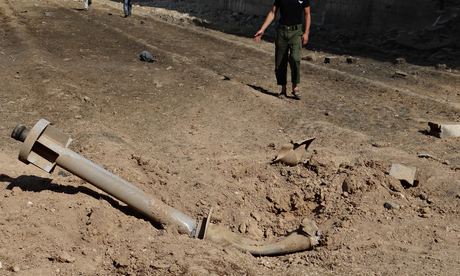
A weapon thought to have been used in the suspected gas attack in the Ghouta, Damascus, that killed hundreds in August 2013. Photograph: Erbin News/Demotix/Corbis
Last week the London Review of Books published an article by the respected Pulitzer prize-winning journalist Seymour Hersh, The Red Line and the Rat Line, in which he details the alleged involvement of the Turkish government with the Syrian opposition group Jabhat al-Nusra in last August's sarin attack in Damascus. Between 1,000 and 1,400 people are estimated to have died.
The US, Britain and other western governments have pinned the blame on the Syrian government; Russia has accused the rebels. Hersh describes this as part of a "false flag" operation designed to draw the US into a conflict with Syria.
In his 6,000-word article Hersh relies heavily on single, unnamed sources for each of his claims, and constructs a narrative in which the Turkish government was responsible for the largest chemical attack since the one carried out by Saddam Hussein on Halabja in 1988. But Hersh's story is full of holes, and it brings the reliability of his sources and conclusions into question.
Hersh makes no mention of the munitions used on 21 August, something that is key to understanding the attacks. In an interview for Democracy Now! he states that the weapons were both homemade and not in Syria's arsenal. Both these claims are wrong.
Two types of munitions were used on 21 August and are linked to the dispersal of sarin gas. Both were recorded in a report by the UN and the Organisation for the Prevention of Chemical Weapons (OPCW) and tested positive for signs of sarin. One was a Soviet-era M14 140mm artillery rocket, certainly not a "homemade" munition, and the second was a munition that was widely unknown.
Studying videos and photographs posted by opposition and pro-government sources has allowed researchers to piece together a great deal of information about these rockets. We know they are referred to as "Volcano" rockets and come in at least three sizes: 107mm, 122mm (as used on 21 August), and a much larger type based on a 220mm rocket motor. It is also clear that there are both explosive and chemical versions, as well as evidence of their use by the Syrian military from late 2012.
Videos and photographs from 21 August show at least eight examples of the chemical type of Volcano rockets. There are three videos from an alleged chemical attack in Adra, Damascus, on 5 August showing the same type of Volcano rockets; one video from Adra in June showing a chemical Volcano rocket; and videos and photographs from December 2012 to January 2013 showing the remains of chemical Volcano rockets. In all examples the rockets have been fired at the opposition and appear to share an identical design, down to the smallest details.
Photographs and footage going back to November 2012 filmed by opposition activists shows Volcano rockets being launched. Eight videos from Mezzeh airbase, near Daraya, from December 2012 show Volcano rocket launches; and from October 2013 the rockets and their launchers began to show up from videos posted by the Syrian government's National Defence Force. Eventually, even pro-Hezbollah sources started posting images of Volcano rockets in action. It is quite clear that no matter how "homemade" Hersh believes the rockets to be, they have been used by the Syrian military for more than a year.
When questioned about this in a recent interview with the Turkish website Diken Hersh dismissed the Volcano rockets, seemingly because he believes a range of "a mile" somehow means they should be discounted as important to his narrative. Hersh refers to the work of Ted Postol and Richard Lloyd who believe the range of the rockets is about 2km. But this range issue isn't the problem Hersh appears to think.
Video footage from both sides of the conflict has allowed researchers to accurately find the positions of government controlled areas on 21 August. The Russian-language news site ANNA News posted two dozen videos showing "Operation al-Qaboun", a Syrian government military operation running from June to August 2013. Embedded with Syrian forces, they were able to film the progress of the operation to clear positions between Jobar and Qaboun, a strip of land about 2km away from the 21 August impact sites.
Videos from opposition groups show the other side of the fighting, including attacks on checkpoints and government movements. Based on this information it appears that the front lines were about 2km away from the furthest impact sites of rockets used on 21 August. Only two rockets landed at the 2km maximum range described by Lloyd and Postol, with the reported impact sites of the remaining rockets being between 1.5km-1.8km away. It has been possible to confirm the precise impact locations of some of the rockets by a combination of GPS information, satellite map imagery, photographs and videos, and around a dozen impact sites were reported by local groups in eastern Ghouta. Hersh's belief that the 2km rocket range is enough to dismiss them from his narrative is clearly misguided.
Despite Hersh's claims we can clearly see that the rockets were used by the Syrian government, and within range of government controlled territory.

No comments:
Post a Comment